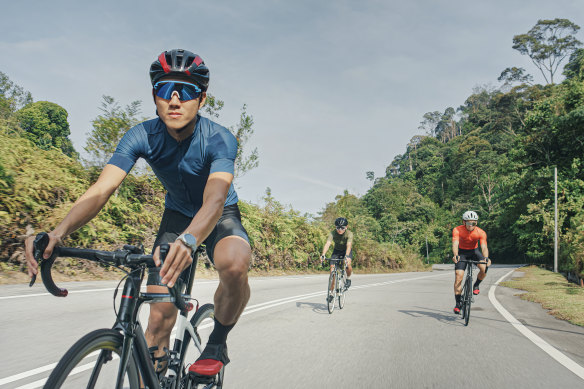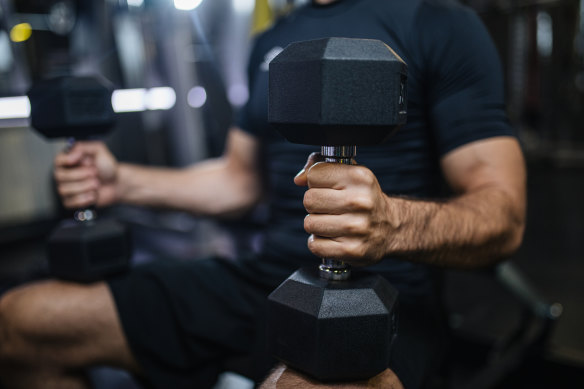This was published 6 months ago
Testosterone boosters are popular among fit men. But are they safe?
By Sarah Berry
For 15 years, Chad* had been going to the gym regularly but recently felt like he was beginning to plateau. Worse, the 43-year-old feared his fitness was slowly declining, while he saw others of the same age continue to improve.
Chad recalls one friend, in particular: “He was getting all these gains, and I was just floundering, and I said ‘I smell a rat, mate’.”
The ‘rat’ was testosterone boosting.

More men are using testosterone therapy or boosters to combat ageing. They come with risks.Credit: Getty Images
New research suggests that testosterone therapy (TRT) is on the rise alongside the use of testosterone-boosters such as peptides and selective androgen receptor modulators (SARMs), a non-steroidal which binds to skeletal muscle and may have fewer side effects than anabolic steroids.
Many healthy middle-aged men also see them as an anti-ageing strategy to restore their lean muscle, strength, sex drive and energy.
Podcast bro Andrew Huberman, 48, started TRT at 45, saying it “gave me a ton of energy”, while 57-year-old Joe Rogan started using it at 39, saying it made him feel “way better”.
“I don’t f--- with hyper-human levels,” Rogan said. “I take what I would have naturally had in my body at 27.”
Men looking for a boost
With alarming news about declining sperm counts, AKA “spermageddon”, and new research of 24,000 men from around the world which found that low T (below 7.4 nmol/L) was associated with a higher risk of mortality, men have become increasingly concerned about their levels and how to boost them.
Dr Vincent Dalbo, a senior lecturer at CQUniversity, says that resistance training increases endogenous testosterone production, but not to the extent of exogenous testosterone.
He uses the analogy of payment in place of testosterone: if your base pay was $20 per hour, then performing heavy compound lifts in the gym may bring your pay up to $25 per hour for three hours following exercise, before it goes back to baseline. TRT brings your base pay to $40+ per hour, and stays there 24 hours per day until you stop taking it.
Chad decided that as long as he didn’t have to use needles, it was worth a go.
Three years ago, he scheduled an appointment with an online doctor to get a script for peptides. The $700 cream he rubbed on his wrist twice a day lasted about eight weeks.
Eventually, the expense drove him to explore alternatives and two years ago he began experimenting with SARMs, which he ordered for himself online
He limits it to two eight-week cycles a year, at a cost of about $370 a cycle because he doesn’t want to look like “steroid abuser” but also to give his body a break. He worries that having too much, too often risks shutting down his body’s ability to produce its own testosterone, and might put pressure on the liver or heart.

Men report improvements in energy and exercise output.Credit: Getty Images
Dalbo says that most people’s testosterone production recovers when they stop TRT: “This is a common fallacy I have heard on the internet, that once you start [TRT or SARMs] you must continue for life.”
However, research does suggest that when taken in high doses (recreationally, people are taking doses as much as 10 times those used in clinical trials), there is risk of testosterone suppression as well as liver injury, kidney injury, increased risk of heart attack and stroke, shrinkage of the testes and male infertility. Products may also not contain what they say they do.
Among 44 products marketed and sold as SARMs, one study found that only 52 per cent contained SARMs. No active compound was detected in 9 per cent of the products, while substances not listed on the label were found in 25 per cent.
“While they may be perceived by some to be safer than steroids, they are not risk-free medicines,” says Nial Wheate, a professor in the School of Natural Sciences at Macquarie University.
SARMs have not been approved in Australia, he says because there is insufficient clinical trial evidence to demonstrate that their benefits outweigh their risks.
Yet, Chad and many like him are willing to take the risk. With young children and a demanding job in sales, the Sydneysider hoped they would improve his energy, provide mental clarity, help him increase muscle mass and recover faster.
Plus, he adds: “They’re supposedly good for anti-ageing.”
Within four weeks of taking the drops, which he bought online and had delivered to his door in an ice-pack, his muscle mass and strength increased alongside his energy and libido.
The results were much more noticeable than when he used the peptides.
“It was a big jump,” he says. “Very quickly you feel like you feel young again, full of energy, and you feel like you could walk through walls.”
Tracking his workout stats on an app, he found he was up 10 and then 20 per cent. Running around after his kids, working hard in the office and at the gym also became easier.
Men like Chad rarely talk openly about what they do – “it’s still a taboo,” he says – but the warnings do little to deter them because of the way the substances make them look and feel.
“Not enough is truly known about it,” he admits. “But, for me, the positives far outweigh any risks that I can see.”

Heavy resistance training naturally boosts testosterone.Credit: iStock
A mythical decline and a better way to boost
Despite the appeal, many experts are concerned by the trend.
Bu Yeap, a professor in the Medical School, University of Western Australia, and a consultant endocrinologist was the lead author of the paper linking low T to a higher mortality risk.
Yeap was also involved with another paper, from April, finding that the combination of testosterone therapy and exercise may be more beneficial than either in isolation.
He says TRT is beneficial in treating the 1-to-2 per cent of younger men with pituitary or testes issues and there is a case to be made (and research to be done) about its potential for men over the age of 65 to “enhance disability-free survival”.
There is a “turning point” around the age of 70 when men’s levels start to decline significantly, Yeap explains. But the “vast majority” of younger men do not need TRT, let alone boosters.
“It’s one of these myths that after the age of 30 your testosterone starts falling off,” he says.
Any decline in testosterone concentration may be related to other factors that coincide with age such as weight gain, diabetes, taking opioids, a drop in lean muscle mass from lack of exercise, high levels of stress, depression, poor sleep, excessive exercise and heavy drinking.
Rob Newton, a professor of Exercise Medicine at Edith Cowan University, reminds us that 75 per cent of Australian men are overweight or obese: “This high level of fat tissue creates hormonal imbalances that are detrimental to health and is one of the main drivers for low testosterone levels.”
About two in three men do not perform sufficient physical activity to maintain normal health and body function and even fewer do at least two resistance training sessions a week.
“Resistance training increases testosterone levels in middle and older aged men both acutely after the training session as well as increasing baseline levels of testosterone with chronic training,” he says, noting that the most effective form is high intensity (e.g. 6-10 repetition maximum with only 1-2 repetitions in reserve) involving large muscle groups (e.g. squat, deadlift, bench press).
By addressing the underlying issues, most men’s bodies will make the right amount of testosterone for them. No side effects included.
The right amount varies significantly between men and can vary depending on when and how a person was tested, so whether they have symptoms is generally seen as more important than a number.
“We emphatically say ‘no’ to buying stuff off the internet or getting stuff from your mate at the gym,” says Yeap. “If men are concerned, they should see their GPs for a thorough health assessment and make sure they are receiving appropriate advice and information.”
*Not his real name.
Make the most of your health, relationships, fitness and nutrition with our Live Well newsletter. Get it in your inbox every Monday.